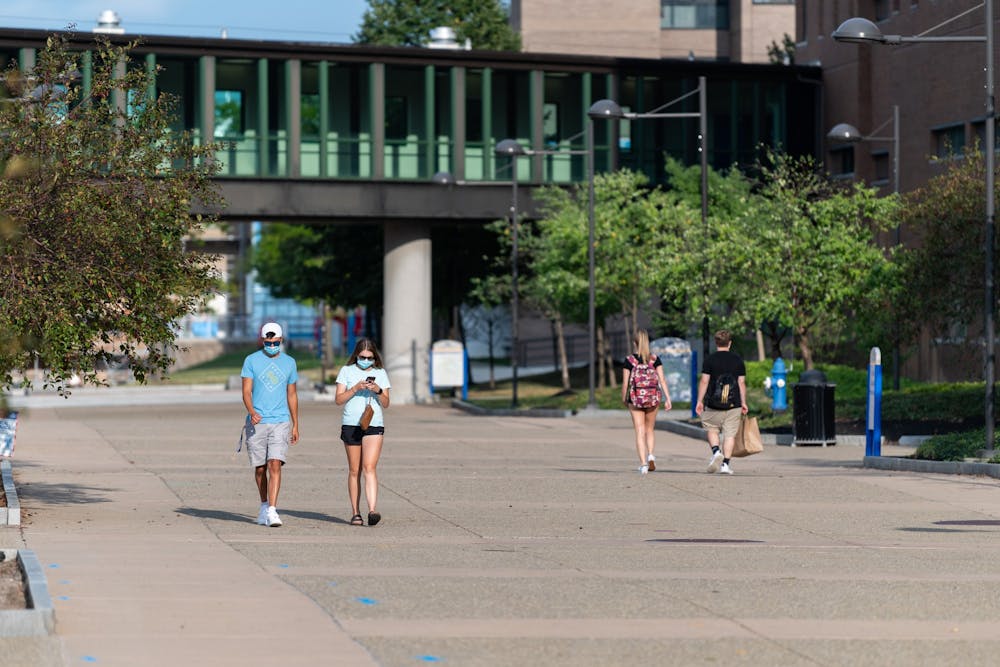The first time Imani Muhammad-Graham ever heard of COVID-19, he laughed about it with his friends.
“[In] January when [COVID-19] was on the news and stuff like that, they were like, ‘Oh, this might [be an issue],’” Muhamad-Graham, now a senior computer engineering major, said. “We were all joking about it. You know, [a] pandemic, we’re all gonna die. And then, uh yeah, that s—t happened.”
Muhamad-Graham says he struggled with distance learning when he was sent home and “only passed [his classes] by the skin of [his] teeth.” But he says he was never scared of the virus.
“I was curious. I wasn’t afraid,” Muhamad-Graham said. “I knew that I was in some hard classes. So I was like, ‘I don’t know how it’s gonna work if I’m gonna go home, [but] it’s just gonna be another experience. It’s gonna be a fun one. It’s gonna go in the history books. So I’m a part of it.’”
On March 11, 2020, UB — and the world — faced the unfamiliar challenge of confronting an emerging infection with the potential of shutting down the global economy. Initially, conflicting information was given to students. That day — a Wednesday afternoon — then-Gov. Andrew Cuomo announced all SUNY and CUNY students would move to distance learning. But hours later, UB President Satish Tripathi announced UB’s campus would remain open — throwing into doubt students’ future on campus.
Ann Malcolm was filling up her car at the Speedway gas station adjacent to campus when her friend told her that all SUNY schools would move to “distance learning.”
“I will never forget how confused and unsettled I felt driving back to my dorm,” Malcolm said.
As an on-campus resident, Malcolm, then a sophomore psychology and health and human services major, was forced to navigate moving out of her dorm room during the early weeks of the pandemic.
“[COVID-19] started to feel real when I came back after spring break to completely move out of my dorm in Greiner [Hall],” Malcolm said. “I lived with three other girls and I was the last one to pick up my stuff, so I walked into an empty suite.”
Malcolm was one of the first students to come face-to-face with UB’s response to the pandemic, which included social distancing, mask-wearing and campus food closures.
“After my mom and I packed everything into our car, we got mac and cheese from the food truck and stood in a socially-distanced line for the first time,” Malcolm said. “That was probably the last time I was on campus without a mask until this week. I remember seeing someone with a mask on moving out and my mom and I were scared that they were sick and a little confused by it. That was probably the first time [we saw] people wear masks in public. UB had already made signs that enforced social distancing and stated [COVID-19] policies. That was also [the] moment where I knew that this would last a lot longer than a few weeks.”
The pandemic not only affected students; it also required quick action from the administration.
Christina Hernandez, then-interim Vice President for Student Life and current associate vice president, was responsible for communicating the university’s new COVID-19 guidelines and keeping students informed. She says she remembers the initial uncertainty surrounding the Centers for Disease Control and Prevention guidelines and UB’s health and safety protocols.
“I remember the first time I heard the term ‘social distancing’ and how most institutions were referring to the whole situation as a ‘temporary new normal,’” Hernandez said in an email to The Spectrum. “The word ‘temporary’ was far from what we all were about to experience.”
She added that even though the pandemic has been challenging, she’s proud of how the campus community pulled together to remain open.
University spokesperson John DellaContrada echoed a similar sentiment. He argues UB made a “successful transition” from distance and remote learning to in-person academics and extracurriculars. He adds that the community still needs to remain vigilant but that they have taken “remarkable” care over the past two years.
In the last two years, millions of high schoolers have graduated and moved onto college — at schools like UB. For many of these students, a college experience marked by COVID-19 is all they know.
Ashanti Petrino, a freshman nursing student, was a junior in high school when she found out she would have two weeks off from school and would need to reschedule her birthday party.
“I was at school and it was a Friday — actually the day before my birthday,” Petrino said. “I had all these plans … everyone was like, ‘Yeah, school is over for two weeks.’ So I’m like, ‘OK, that’s fine.’ I had rescheduled and made plans to celebrate my birthday two weeks later. Then the two weeks got extended for a month. And then I didn’t want a birthday and those plans [anymore].”
Petrino says readjusting to an academic setting has been hard in the post-2020 world.
“It’s insane,” Petrino said. “I’ve gotten really bad anxiety because the transition, it’s not easy. Going from [COVID-19], and then my first year [with] not having people around or anything. That first semester was really hard for me — being around people, teachers, talking — it was really hard. But I guess it’s fine, [we’re] going slowly into the new normal, and not having the masks on, that’s really nice.”
Jack Porcari contributed reporting to this story.
Julie Frey is a senior/news features editor and can be reached at julie.frey@ubspectrum.com

Julie Frey is a senior news/features editor at The Spectrum. She is a political science and environmental studies double major. She enjoys theorizing about Taylor Swift, the color yellow and reading books that make her cry. She can be found on Twitter @juliannefrey.





